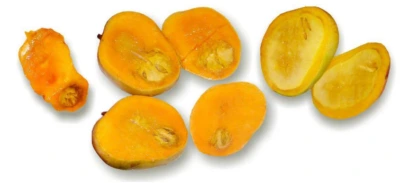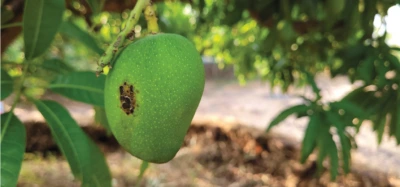FAQs
Your Questions, Answered with Care
Alphonso mangoes, often hailed as the “King of Kings” among mangoes, are prized for exceptional qualities. These delectable fruits boast a rich, sweet flavour, delightfully smooth and buttery texture, and a wealth of vitamins and minerals. Their unique origin in the Konkan region of Maharashtra, India, is further recognized by a prestigious Geographical Indication (GI) tag. Despite its great flavour and taste, this King is not perfect and comes with some internal pulp defect, Spongy Tissue.
The purpose of this disclaimer is to educate our consumers about the irregularities associated with Alphonso Mangoes.
Alphonso mangoes, despite their exquisite taste and texture, can sometimes suffer from a physiological disorder known as “Spongy Tissue.” This disorder causes an internal breakdown within the mango’s pulp, characterized by sections of unripe, acidic, and pale yellow or white tissue with a corky texture. These areas may have air pockets and carry an unpleasant off-flavour. Frustratingly, fruits with spongy tissue show no external symptoms, and the problem is only visible once the mango is cut open.
Mangoes with spongy tissue

A mango with the white part inside should still be safe to eat but will probably be less flavourful. The rest of the fruit, however, can still be perfectly fine and still certainly edible.
The cause of spongy tissue formation in alphonso mango has been traced to the shift of seed into germination mode with an intact funiculus connection at hilum and a metabolically active embryo, around 60% maturity stage of fruits and the consequent drawl of water and other resources from the adjoining mesocarp tissue. Physiological, biochemical and radiotracer tritium studies have confirmed the shift of seed in to germination mode around 60 to 70% maturity stage of the fruit. Induction of seed dormancy and/or down regulation of seed metabolism at the right physiological maturity stage of fruit was found to be the right strategy for prevention of spongy tissue in alphonso mango.
(Source – Indian Institute of Horticultural Research –
Investigations on the molecular physiology of fruit disorders – spongy tissue in Alphonso Mango (Ongoing) | ICAR-Indian Institute of Horticultural Research )
Store unripe mangoes at room temperature. The ideal temperature range for efficient ripening is between 26°C and 32°C. Avoid storing them in an air-conditioned environment, as the cooler temperatures can slow down the ripening process. Left at room temperature, unripe mangoes will naturally become sweeter and softer over several days. To speed up ripening, keep the mangoes in the shipping box itself with layers of paper and grass as arranged for shipping at room temperature, or mangoes can be kept in a paper bag or can be wrapped in cloth. Mangoes ripe fast in humid weather. Dry weather or fall in temperature at night will delay the ripening process. Once ripe, mangos can be moved out of the box or paper bag or cloth and can be kept on plain paper or on cloth spread in open air at room temperature. This will allow it to keep mangoes in good condition for further 4-5 days.
Ripe mangoes can be moved to the refrigerator which will slow down the ripening process. Whole ripe mangos may be stored for up to five days in the refrigerator. But once removed from the refrigerator, one must consume it immediately otherwise it will start getting spoiled.
Mangoes may be peeled, cubed, and placed in an airtight container in the refrigerator for several days. You can also store them in the freezer for up to six months.

When choosing a mango, consider how firm it feels and when you will be eating it. Do not rely solely on colour, as it is not the most reliable indicator of ripeness. As mangoes ripen, they become softer to the touch. A fully ripe mango will also have a distinct, sweet aroma near the stem end. Keep in mind that the red colouring on some varieties does not necessarily mean the fruit is ripe. Always judge by feel.
Ideal conditions for ripening mangoes are very specific. Temperature should be around 30oC. Humidity should be in excess of 60%. Mangoes tend to lose approximately 10-25% weight during the ripening process, while ripening mangoes release carbon dioxide, ethylene and they also dehydrate. These released gases form an aura surrounding each fruit which helps in naturally ripening the mangoes.
We use a ripening chamber for ripening of mangoes, which accelerates the ripening process which reduces the ripening time of the mangoes by 2 days. Ripening chamber is a room which is thermally insulated where temperature is controlled between 27oC and 30oC. Carbon dioxide is maintained below 2500 ppm and 30 – 50 ppm ethylene gas is circulated in the room by using an automated control system. The ripening of mangoes in the chamber helps in reducing post-harvest losses like stem rot due to controlled temperature. It also helps in extending the shelf life of mangoes.
Identifying the right time to harvest is key in Alphonso Mango. Alphonso mangoes are typically harvested when they are at 80-85% maturity, the balance 15-20% is the time it takes to fully ripe from the time of harvest.
To determine the maturity of a mango, following 3 key points are checked –
- The fruit gets the round shape from the bottom side.
- The small dots on the skin of the fruit will start to move away from each other.
- There will be a small dip near the stem area.
The skin should be a light green colour with a slight yellow blush. The flesh of the mango should also be light yellow and slightly translucent. Every fruit on the tree is checked manually by the harvester and carefully plucked by the plucking instrument named Zela (झेला) or Ghal (घळ).
Alphonso mango is plucked along with the stem, leaving at least 20 – 30 mm of stem attached to the fruit. If we pluck the fruit without the stem, the sap coming out from the stem will damage the skin of the fruit leaving the spots on the fruits. This damage is cosmetic only as it will not affect the taste or the pulp of the fruit, but it invites the fungus and resulting black spots will lower marketability of fruits.
Mangoes need to be handled carefully. Alphonso mangoes are delicate fruits and can easily be bruised. One must be careful not to drop or jostle the mangoes during harvesting and handling.
After harvesting from trees, the helper keeps the mangoes in a cool, shady place. Alphonso mangoes should be kept cool and out of direct sunlight after harvesting. This will help to preserve their quality and shelf life. Harvested fruits are stored in plastic crates and carried to the packing house for further processing.
It is recommended by the agricultural university that harvesting of Alphonso mangoes should be carried out during morning and evening only and harsh sunlight should be avoided, but practically it is not possible to harvest only for limited hours of the day considering the short period of the season.

Each fruit is carefully handled during the sorting process. The length of the Stalk of the fruit is kept in the range of 20 – 30 mm. The stalk is cut using the secator. The fruits are sorted in 2 grades –
- Grade 1 – fruits without any marks or stains on it or fruits with very small marks or stains.
- Grade 2 – fruits with big marks or stains spread across the fruits.
These marks or stains are caused due to various natural means like rubbing of fruit with nearby branches or fruit on trees or due to harm by various pests, insects, or fungi.
After this part of grading, each grade of fruit is sorted as per their sizes on an electronic weighing scale. Electronic weighing scale sort up to 60 fruits per minute.
Sizes are as follows –
- Size XL – more than 271 gm
- Size L – 241 – 270 gm
- Size M – 211 – 240 gm
- Size S – 181 – 210 gm
These weights are measured on the day of harvest, mangoes tend to lose approximately 10-25% weight during the ripening process. This weight loss varies from area to area of the mango orchard. Mangoes from the trees on the slopes with good soil tend to lose less weight as compared to the mangoes from trees on the rocky surface (table land). During the ripening process, fruits release ethylene, carbon dioxide and they dehydrate, causing weight loss. The aura of ethylene formed around the fruit results in the ripening of the fruit.

We have different delivery systems for different locations. We use good quality cardboard boxes for packing mangoes. Each fruit is packed with utmost care.
Alphonso mangoes are very sensitive to very small changes in atmosphere. Ideal temperature for mango ripening is 28 – 32°C. If the temperature rises above 34°C., store the mangoes in a well-ventilated place. In summers, in many cities across Central India, temperatures go up above 40°C. So, when you receive the mango box in similar conditions, open the box as early as possible and remove the mangoes from the box and spread the mangoes on paper or cloth in a well-ventilated place. Avoid direct sunlight.
Generally, when you receive the mango box, open the box as early as possible and take out the yellow colour mangoes from the box and spread them on the paper or cloth in a well-ventilated place. Keep the green-coloured mangoes in the box only in between the layers of grass and paper, till they turn yellow.
